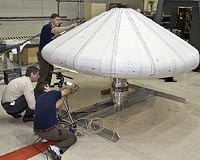 |
Washington DC (SPX) Aug 17, 2009 Forty years after man landed on the moon, NASA plans to retire the Space Shuttle in 2010. It will be five years before NASA has a vehicle ready to carry astronauts back into space, which has some concerned about the future of the space program. Kane Farabaugh sat down with Apollo astronaut Jim Lovell to discuss what is in store for space exploration. When astronaut Jim Lovell aimed for the moon during the Gemini and Apollo missions, he says there was a sense of excitement and adventure shared by people around the world. He served as Neil Armstrong's backup during the Apollo 11 lunar landings, and watched the dramatic event unfold from NASA's mission control center in Houston Texas. "After the flight, I had made a trip overseas to Europe, and was really pleasantly surprised that almost all the Europeans were absolutely enthusiastic about what we had accomplished, perhaps just as much so as the Americans were," he said. Lovell, who once held the record for most hours in space, never landed on the moon. As commander of Apollo 13, slated to be the third moon landing in 1970, Lovell successfully led fellow astronauts Fred Haise and Jack Swigert back to Earth after a catastrophic explosion crippled their spacecraft. Now, 40 years after man landed on the moon, and 39 years after Lovell returned to Earth, NASA plans to retire the Space Shuttle in 2010. It is the only vehicle NASA has to carry astronauts into space, and Lovell is concerned about the future of the space program. "There's going to be a five year hiatus between getting some other new vehicle to go up to the space station before we could have something to go," he added. "Nothing is going to be there except the Russian Soyuz, a vehicle that was developed years and years ago." At the Marshall Space Flight Center in Huntsville, Alabama in late July, NASA held meetings with an independent review panel commissioned by President Barack Obama to evaluate the future of manned space flight. Part of the meeting focused on the next generation spacecraft that would replace the Space Shuttle Orbiter. NASA is developing the Constellation program, a beefed-up Apollo-like initiative. It uses a rocket, called Ares, to put a single-use spacecraft, called the Orion, into orbit, and eventually back to the moon. Steve Lindsay, chief of the Astronaut Office at NASA's Johnson Space Center, says one of the main drives behind the new vehicle is to reduce the risk with spaceflight. "We know that in the future we're going to take a lot of risks," he noted. "We know in the present we're going to take a lot of risks. We know even with an order of magnitude of improvement, we are still going to take a lot of risks. But, we think a risk should be commensurate with our level of experience. We're willing to take those risks. We accept that as our job and we're proud to do that as our job." Another option favored by the presidential panel is extending the life of the Space Shuttle through 2014, keeping it flying missions until a new spacecraft is ready for flight. The panel is also reviewing an extension to the proposed life of the International Space Station, currently scheduled to end its mission by 2015. The Obama administration is concerned about the program's price increases. Public support for funding the space program has waned in recent years. Now, in the midst of a deep recession, lawmakers are looking to trim expenses and NASA is struggling to keep funding intact. But Lovell sees an opportunity for economic recovery by increasing funding to the space program. "One part of the stimulus could be the space program," he said. "First of all it's a creative program, it creates taxes individual and corporate taxes, all the money is spent here on Earth, not one cent up there in space. It brings technology that spills over to the private sector. That's what happened all through Gemini and Apollo and the private sector now is affected by computer technology and electronic components that were speeded up by our being in space, and that could continue." Lovell sees a renewed interest in space sparked by China's Lunar Exploration Program. He says the only successful path to an eventual manned mission to Mars is a shared vision and cooperation among all countries interested in venturing farther into the universe. Share This Article With Planet Earth
Related Links NASA Space Tourism, Space Transport and Space Exploration News
 Rocket To Launch Inflatable Re-entry Capsule
Rocket To Launch Inflatable Re-entry CapsuleHampton VA (SPX) Aug 17, 2009 Inflatable aircraft are not a new idea. Hot air balloons have been around for more than two centuries and blimps are a common sight over many sports stadiums. But it's hard to imagine an inflatable spacecraft. Researchers from NASA's Langley Research Center in Hampton, Va., are working to develop a new kind of lightweight inflatable spacecraft outer shell to slow and protect reentry ... read more |
|
| The content herein, unless otherwise known to be public domain, are Copyright 1995-2009 - SpaceDaily. AFP and UPI Wire Stories are copyright Agence France-Presse and United Press International. ESA Portal Reports are copyright European Space Agency. All NASA sourced material is public domain. Additional copyrights may apply in whole or part to other bona fide parties. Advertising does not imply endorsement,agreement or approval of any opinions, statements or information provided by SpaceDaily on any Web page published or hosted by SpaceDaily. Privacy Statement |